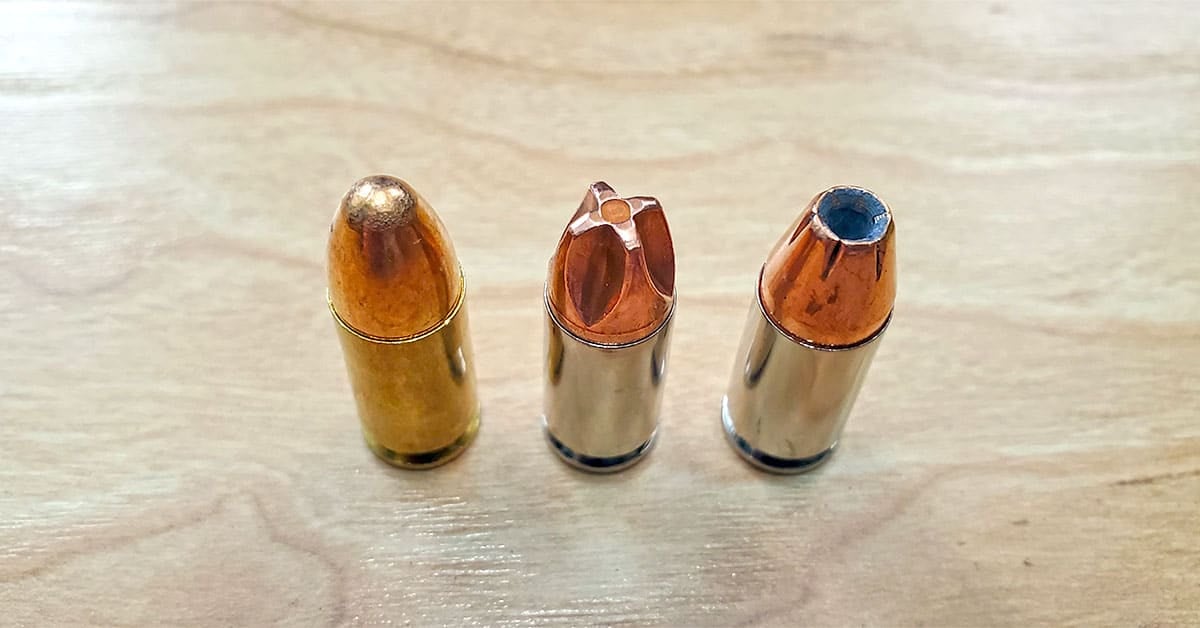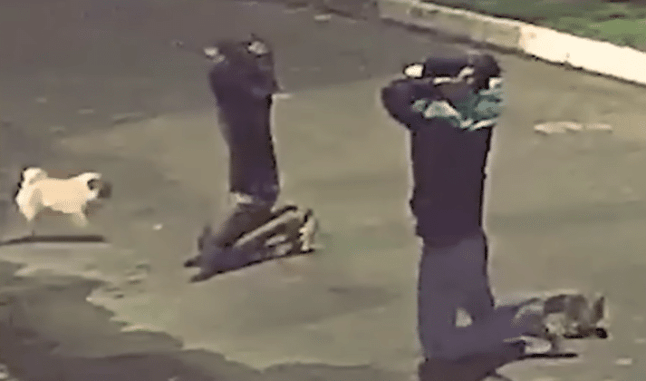When it comes to firearms, understanding the different ammo types is crucial for both safety and effectiveness. For beginners, terms like JHP, FMJ, and +P can be confusing. This guide will help you understand these types of ammo and their uses.
Table of Contents
Different Ammo Types Explained
There are a lot of different types of bullets out there. In a self-defense situation, some bullets can give an advantage over others. With each pro, there’s usually a con. And in the bullet family tree, every round is related by at least a first or second cousin.
In this article, we’ll go over a few of the different types of ammo available. Most people will talk about JHP vs. FMJ, but there are more. We can’t cover every single type, but we will be covering the most common varieties. With ammo types explained in a simple fashion, you’ll be understanding them before you know it!
Full Metal Jacket (FMJ)

Full metal jacket (FMJ or FMC) refers to the copper or steel alloy coating on the bullet to reduce lead residue left in the barrel after firing. These rounds are reserved for the range, as they are cheaper in cost and not meant for self-defense.
Advantages of FMJ:
- Penetration: FMJ rounds are excellent at penetrating targets, which makes them effective for military applications where shooting through barriers might be necessary.
- Cost: Generally cheaper to produce and buy, making them a popular choice for target practice and training.
- Reliability: FMJ bullets feed reliably in a wide variety of firearms due to their smooth, rounded shape.
Disadvantages of FMJ:
- Over-penetration: Because FMJ bullets do not expand upon impact, they can pass through targets and continue traveling, posing a risk to bystanders.
- Less stopping power: The lack of expansion means less energy is transferred to the target, reducing the immediate stopping power compared to JHP rounds.
Usages of FMJ:
- FMJ: Primarily used for training, target shooting, and military applications where penetration through barriers is necessary.
Jacketed Hollow Point (JHP)

Hollow point rounds have a hollowed out center. When a hollow point strikes its target, the hollow causes the bullet to deform. It looks like a mushroomed gob of lead pushing through. The results are devastating. Because the bullet expands inside the soft target, it pushes out a larger surface area of tissue. The jacketed version has a thin covering of copper or steel, like the one seen above. This means less lead powder coating the inside of the barrel.
Advantages of JHP:
- Expansion: Upon impact, the hollow point causes the bullet to expand, creating a larger wound channel and increasing the likelihood of incapacitating the target.
- Reduced Over-penetration: The expansion reduces the bullet’s ability to pass through the target, decreasing the risk of unintended injury to others.
- Stopping Power: The energy transfer upon expansion makes JHP rounds more effective at stopping threats quickly.
Disadvantages of JHP:
- Cost: JHP bullets are generally more expensive than FMJ bullets, making them less ideal for high-volume shooting practice.
- Feeding Issues: Some firearms might have feeding issues with JHP rounds due to the shape of the bullet, although modern firearms are usually designed to handle them.
Usages of JHP:
- JHP: Preferred for self-defense and law enforcement due to their superior stopping power and reduced risk of over-penetration.
Related: Non-jacketed hollow points (HP)
Overpressurized Ammunition (+P)
This is ammunition made with a higher pressure than the standard rounds of its caliber. The end product is faster muzzle velocity and greater penetration. Some handguns deal with the added stress of over-pressurized ammunition quite well. Others may malfunction. With any ammunition, you should always run some through your firearm to make sure it works as intended.
Advantages of +P Ammunition
- Increased Velocity: The higher pressure propels the bullet at a faster speed, which can improve performance in terms of penetration and terminal ballistics.
- Greater Stopping Power: The increased velocity can translate to more energy being transferred to the target, potentially enhancing the round’s ability to incapacitate an assailant quickly.
- Better Expansion: For +P JHP rounds, the higher velocity can improve the bullet’s expansion upon impact, creating larger wound channels and increasing stopping effectiveness.
Disadvantages of +P Ammunition
- Increased Recoil: The higher pressure results in more felt recoil, which can affect shooting accuracy and follow-up shot speed, especially in lighter, compact firearms often used for concealed carry.
- Increased Wear on Firearms: The extra pressure can accelerate wear and tear on the firearm’s components, especially if used frequently. It’s crucial to ensure your firearm is rated for +P ammunition.
- Cost: +P rounds are typically more expensive than standard rounds, making them less ideal for regular practice and training.
- Noise and Muzzle Flash: The increased pressure can result in louder gunfire and more pronounced muzzle flash, which can be a factor in low-light situations.
Usages of +P Ammunition
- Self-Defense: +P ammunition is often favored for self-defense due to its enhanced stopping power and performance, making it a popular choice for law enforcement and personal protection.
- Training: Due to the increased cost and wear on firearms, +P ammo is less commonly used for regular training. Shooters might practice with standard rounds and occasionally train with +P to familiarize themselves with the recoil and performance.
Related: JHP+P+ – Overpressurized Jacketed Hollow Point is a combination of a jacketed hollow point’s increased damage to soft tissue with the increased velocity and penetration of a +P round.
Soft Point Bullet (SP or JSP)

This is a bullet with an exposed lead up. It can also sometimes be called a “partially jacketed bullet”. Unlike a full metal jacket that completely encases the bullet in a coating of metal alloy, the soft point leaves a portion exposed. This causes it to expand upon impact – creating a greater surface area. It also fouls up the barrel of a firearm less than non-jacketed bullet. JSPs are considered a good middle ground between a hollow point (HP) and a semi-wadcutter (SWC, below).
Advantages of SP:
- Controlled Expansion: The exposed lead tip allows the bullet to expand upon impact, creating a larger wound channel and increasing stopping power.
- Penetration: The jacketed body maintains structural integrity, ensuring adequate penetration even after expansion.
- Versatility: Suitable for various applications, including hunting medium to large game and self-defense.
Disadvantages of SP:
- Less Expansion than JHP: SP bullets do not expand as reliably or as much as Jacketed Hollow Points (JHP), potentially resulting in less immediate stopping power.
- Risk of Over-penetration: In self-defense scenarios, SP bullets may still penetrate through the target, posing a risk to bystanders.
Usages of SP:
- Soft Point (SP): SP bullets are commonly used for hunting due to their balance of penetration and expansion. They are suitable for medium to large game and can also be used for self-defense, though they are less common in this role compared to JHP bullets.
Semi-Wadcutter (SWC)

This type of bullet has a blunted tip. It’s typically favored in .38 snub-nose style revolvers. Where a rounded tip would slide through a target, the flat tip (“meplat”) punches a big hole.
Advantages of SWC:
- Clean Holes: The flat tip and sharp shoulder create clean, easy-to-score holes in paper targets, making them ideal for precision shooting and competition.
- Good Penetration: The conical shape provides good penetration, making SWC bullets effective for hunting small to medium game.
- Versatility: Useful for both target shooting and hunting, SWC bullets are a versatile choice for various shooting activities.
Disadvantages of SWC:
- Limited Expansion: Unlike SP bullets, SWC bullets are not designed to expand upon impact, which can limit their effectiveness for self-defense.
- Feeding Issues: Some semi-automatic firearms may have difficulty feeding SWC bullets reliably due to their shape.
Usages of SWC:
- Semi-Wadcutter (SWC): SWC bullets are popular for target shooting and competition because of their ability to create clean holes in targets. They are also used for hunting small to medium game, where deep penetration is desired.
Related: Wadcutter (WC) – Wadcutters have wider, flatter meplats than SWC.
In the middle of these broad categories are a number of really good styles of ammunition. One of which is Hydra Shok. It’s a proprietary type of ammunition made by Federal Cartridge. It’s a partially jacketed hollow point with a center post in the middle. To exposed soft tissue, it’s characterized by a deep wound channel. Hydra Shoks are more of a hybrid animal.

Another example is the Xtreme Defender round offered by Underwood Ammo. That’s the one in the center in the above image. This round is not in any category above, but is a very effective round for self-defense.
What type of bullet works best for your self-defense? A lot of concealed carriers use JHP+P to get some extra penetration out of their hollow points. Some prefer the slow muzzle velocity but big punch of an SWC. For practice at the range, stick with FMJ.
JHP vs. FMJ = Self-Defense vs. Range
Ammo Types Explained: Overview
Here’s a summary of the different ammunition types we’ve discussed, including their best uses, pros, and cons:
Full Metal Jacket (FMJ)
Best For:
- Target practice
- Training
- Military applications
Pros:
- Excellent penetration
- Cost-effective
- Reliable feeding in various firearms
Cons:
- Risk of over-penetration
- Less stopping power compared to expanding bullets
Jacketed Hollow Point (JHP)
Best For:
- Self-defense
- Law enforcement
Pros:
- Superior stopping power
- Reduced risk of over-penetration
- Better expansion upon impact
Cons:
- More expensive than FMJ
- Potential feeding issues in some firearms
+P Ammunition
Best For:
- Self-defense
- Situations requiring enhanced stopping power
Pros:
- Increased velocity
- Greater stopping power
- Improved bullet expansion (for JHP +P)
Cons:
- Increased recoil
- Accelerated firearm wear
- Higher cost
Soft Point (SP) Bullets
Best For:
- Hunting medium to large game
- Self-defense (secondary to JHP)
Pros:
- Controlled expansion
- Good penetration
- Versatile
Cons:
- Less expansion than JHP
- Potential for over-penetration
Semi-Wadcutter (SWC) Bullets
Best For:
- Target shooting
- Competition
- Hunting small to medium game
Pros:
- Clean holes in targets
- Good penetration
- Versatile
Cons:
- Limited expansion
- Potential feeding issues in semi-automatic firearms
Conclusion
Selecting the appropriate type of ammunition depends on your specific needs and intended use. For self-defense, JHP and +P ammunition provide superior stopping power and controlled expansion. FMJ rounds are ideal for target practice and training due to their cost-effectiveness and reliable feeding. Remember, one of the big debates is JHP vs. FMJ, and how you know what their purposes are.
Soft Point bullets offer a balance between penetration and expansion, making them suitable for hunting and some self-defense situations. Semi-Wadcutter bullets excel in target shooting and hunting small to medium game, thanks to their clean-cutting design and good penetration.
Understanding these ammo types explained ensures that you choose the best ammunition for your particular situation.
Safety Tip: Always store your ammunition in a cool, dry place to maintain its effectiveness and ensure that it is out of reach of children. Regularly check your ammunition for any signs of damage or corrosion before use.













![[BEGINNERS GUIDE] Prepare For Multiple Threats](https://imagedelivery.net/sbm_lYeJbALkepJgtmRD5w/concealednation.org/2015/08/ScreenHunter_121-Aug.-09-15.37.jpg/w=728,h=381)
